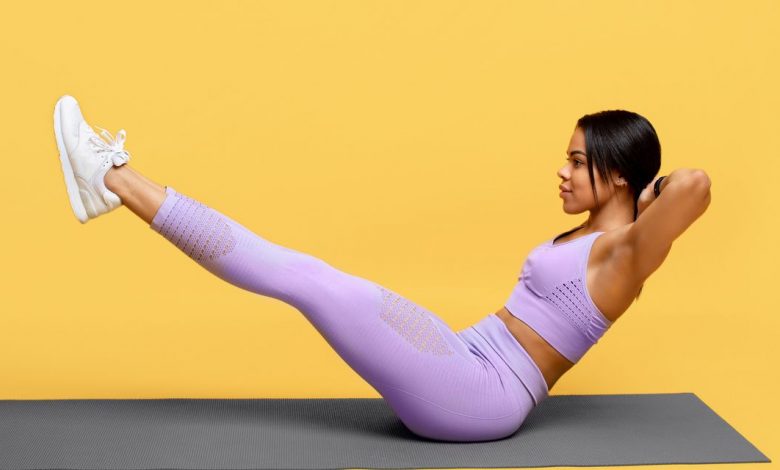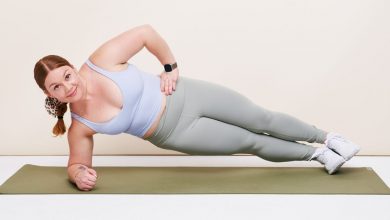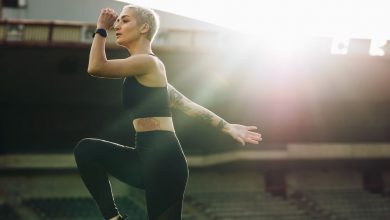6 Reasons to Work Your Core That Have Nothing to Do With ‘Getting Abs’

All products featured on Self are independently selected by our editors. However, we may receive compensation from retailers and/or from purchases of products through these links.
A quick scan of any gym will show you: Abs exercises are one of the most popular ways people fill their workout time. That’s great—but many folks fall into the trap of prioritizing core workouts in order to try to get visible abs, which just isn’t the way you should be thinking of these powerhouse moves.
“A strong core is more than visible abs,” sports rehab specialist Kimberly Melvan, DPT, CSCS, tells SELF. And striving for that as your ultimate outcome can make you “lose sight of exercising for total mind and body wellness,” she says. “Working out can give you confidence, but if aesthetics is all you are focused on, you can get lost in expectations and comparisons.”
This isn’t to say you should stop doing abs exercises, though—in fact, shoot to hit those areas at least twice a week for overall health and wellness, Dr. Melvan says—but it’s more about reframing what these moves can bring you. To be clear, there are tons of benefits of core strength that have absolutely zero to do with how those muscles look on your body. Read on to find out the biggies.
1. Core strength can help you stand up straighter.
A major benefit of doing core exercises regularly is that it can lead to better posture, Dr. Melvan explains. “A strong core helps you stand and sit taller and makes breathing easier,” she says.
That’s because your core isn’t just your rectus abdominis, or the muscles that run vertically across the front of your stomach. It’s also made up muscles along the sides of your abdomen (your obliques) and your lower back (erector spinae and quadratus lumborum), as well as the deepest muscles underneath (transverse abdominis).
These back muscles provide joint stability throughout your spine, which helps maintain good posture, according to a 2018 study in Scoliosis and Spinal Disorders. And all together, those core muscles act like a corset, keeping everything steady and stable, exercise physiologist Janet Hamilton, CSCS, tells SELF. This allows them to generate energy elsewhere—like above, to your torso, to help keep you upright and not slouching.
“Don’t forget, though, that the core isn’t complete without a nice strong and functional set of pelvic floor muscles,” Hamilton says. “The pelvic floor literally is the floor of the core.” Pelvic floor muscles support the function of your bladder, bowel and the uterus, and research shows a link between women with urinary incontinence and pelvic floor muscle dysfunction and poor posture.
2. It could ward off back pain…
Lower back pain affects 619 million people worldwide, and by 2050, that number could grow to 843 million, per a 2023 review in The Lancet Rheumatology. The good news: Better core strength can reduce your risk of lower back pain, Hamilton says. In fact, there’s a link between weak core muscles and pain in that area, Dr. Melvan says.
For instance, a small 2015 study in Journal of Back and Musculoskeletal Rehabilitation found that doing exercises that strengthen the core is an “effective rehabilitation technique” for people who experience chronic low back pain. And a 2015 review of 135 research articles in the Journal of Physical Therapy Science confirms core strength training is a legit way to ease those aches.
Basically, a strong core “stabilizes the lower back and takes pressure off the back,” Dr. Melvan says. Think about it this way: Your spine is like a stack of children’s building blocks; muscles connect one block to the next—or span multiple segments of the spine—to keep it from tipping, Hamilton explains.
Your abdominal muscles stabilize your spine, per Hamilton; if they’re weak, then your stack of blocks—a.k.a. your spine—potentially won’t be as well supported. The result? Possible muscle injury in one or more segments, leading to back pain and dysfunction when doing activities like lifting your child off the floor or doing a deadlift in the gym, according to Hamilton.
3. …And lead to fewer injuries lower down the chain to boot.
A strong core may also reduce your risk for injuries in your knees and hips, according to Hamilton.
In fact, a small 2023 study in Scientific Reports found that core stability training can reduce the risk of ACL injuries caused by improperly landing from a jump. That’s because a weak core can interrupt your muscles’ energy transfer and create “abnormal” movement patterns that can increase your risk of injury.
“When you run, jump, lift, or otherwise generate force in your lower body to accomplish a task, if your core isn’t strong, then those forces will potentially result in unintended motion in the joints of the lower body, hips, or core,” Hamilton says.
If your core isn’t doing its job, other muscles have to try and compensate. That can contribute to overuse injuries in muscles that are “very distant anatomically but highly linked biomechanically,” Hamilton says, like in your knees, ankles, or feet.
4. Core strength can help you balance better.
A strong core can be a trifecta to ward off falls, particularly as you age: It can boost balance, coordination, and proprioception—your awareness of your body in the space around you, Dr. Melvan says.
Research backs this up: A small 2020 study in the Journal of Research in Rehabilitation Sciences found that eight weeks of core stability training improved balance in older adults with a history of falls. Another small 2018 study in Acta of Bioengineering and Biomechanics suggests that a single session of core training is enough to see a temporary boost in balance for 24 hours after.
And it’s not just about falls, either: Having good balance is important for younger folks who do activities like running or lifting in the gym. If you take a wobbly step on a rock outside or standing up from a lunge, “Your foot position is instantly thrown off and your ability to survive that disruption without a fall may come down to how strong your core is,” Hamilton says. “Can you react quickly enough and do you have enough power to right yourself and bring your center of gravity back to where it needs to be?”
5. It can make your workouts more efficient.
If you want to boost your athletic performance, power, and running efficiency, and be able to recover quicker, a strong, stable core is a necessity, according to Dr. Melvan. And Hamilton agrees.
“Core strength is vital for good lifting mechanics, and a stable core helps you transmit and utilize the power that’s generated in your legs,” Hamilton says. Say, for instance, you’re deadlifting at the gym: “In order to lift the bar and return to normal standing position, one must generate significant force in the calves, hamstrings, glutes, and low back, along with enough stabilizing force in the core muscles to keep the spinal segments properly stabilized and aligned,” Hamilton says. And if you’re pushing a barbell overhead in a shoulder press, solid core strength can give you the foundation you need to avoid tipping over.
Plus: The more power you’re able to generate, the more weight you’re able to lift, which can help overall with your strength or muscle-building goals.
While a strong core comes in clutch in the weight room, it can also help in other workouts too. “Your ability to sprint and change directions—think activities like tennis and pickleball, for example—is improved with a strong and stable core,” Hamilton says. A 2022 review in Frontiers in Physiology listed a whole bunch more too, including football, handball, basketball, swimming, dancing, karate, Muay Thai, gymnastics, volleyball, badminton, and golf.
6. A strong core can help you simply move better.
“Doing core exercises improves mobility with everyday tasks,” Dr. Melvan says. And by “mobility,” we essentially mean your ability to move through your day with ease. Without it, you might have a hard time doing things like going up and down stairs, lifting your pets or small children, or putting your groceries away.
So no, doing core exercises in the gym won’t guarantee you visible abs. What these moves do assure you, however, is a better quality of life. A strong midsection helps give your posture a boost, reduces your risk of injuries, betters your balance, and helps you move better on the daily. And who doesn’t want all that?
Related:
- Do I Get a ‘Better’ Cardio Workout If I Go Faster or Longer?
- 25 Signs of a Successful Workout That Have Nothing to Do With Sweat or Soreness
- 6 Small, Everyday Things Physical Therapists Wish You’d Stop Doing
Get more of SELF’s great fitness coverage delivered right to your inbox—for free.



